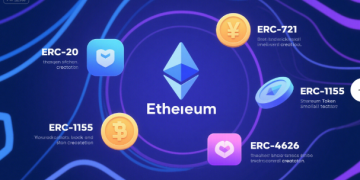Ethereum tokens are the backbone of the decentralized economy, powering everything from DeFi protocols to NFT marketplaces. As the most established smart contract platform, Ethereum continues to dominate the blockchain space, with its token standards and ecosystem innovations setting the gold standard for Web3 development. In this article, we delve into the core aspects of Ethereum tokens, explore their technical foundations, and analyze the trends shaping their future in 2025 and beyond.
Understanding Ethereum Tokens: Core Concepts and Standards
Ethereum tokens are digital assets created on the Ethereum blockchain through smart contracts. Unlike Bitcoin, which serves solely as a currency, Ethereum tokens enable a wide range of functionalities, from representing ownership (ERC-721) to facilitating decentralized finance (ERC-20). The Ethereum ecosystem supports multiple token standards, each tailored to specific use cases:
ERC-20: The Foundation of Fungible Tokens
The ERC-20 standard, introduced in 2015, revolutionized tokenization by providing a set of rules for fungible tokens. These tokens are interchangeable and widely used for cryptocurrencies, utility tokens, and liquidity pools. Key features include transferability, balance tracking, and allowance mechanisms, making ERC-20 tokens compatible with wallets, exchanges, and DeFi platforms . Projects like Uniswap and Chainlink rely on ERC-20 tokens to enable decentralized trading and oracle services.
ERC-721: Unlocking Non-Fungible Assets
ERC-721 tokens are non-fungible, meaning each token is unique and indivisible. This standard is the bedrock of the NFT industry, allowing creators to tokenize art, collectibles, and virtual real estate. For example, CryptoKitties and Bored Ape Yacht Club use ERC-721 to authenticate ownership and enable peer-to-peer transactions. Unlike ERC-20, ERC-721 tokens track individual ownership and metadata, fostering scarcity and value .
ERC-1155: The Multi-Token Revolution
ERC-1155 combines the best of ERC-20 and ERC-721, allowing a single smart contract to manage multiple token types (fungible and non-fungible). This efficiency reduces gas costs and simplifies batch transactions, making it ideal for gaming assets, loyalty programs, and hybrid financial instruments. For instance, a game could use ERC-1155 to issue both fungible in-game currency and rare non-fungible items .

ERC-4626: Optimizing Yield-Bearing Vaults
In 2025, the ERC-4626 standard has emerged as a game-changer for decentralized finance. It standardizes yield-bearing vaults, allowing users to deposit ERC-20 tokens and receive tokenized shares representing their stake in the vault. This innovation streamlines DeFi integration, enabling protocols like Yearn Finance to offer seamless yield farming and automated portfolio management .
Developing Ethereum Tokens: Tools and Best Practices
Creating an Ethereum token requires proficiency in Solidity, the primary programming language for Ethereum smart contracts. Developers can leverage frameworks like Truffle and Hardhat to streamline the development process, while OpenZeppelin provides audited contract templates to ensure security and compliance with ERC standards .
Key Steps in Token Development
- Define Token Parameters: Specify total supply, decimals, and token name/symbol.
- Choose a Standard: Select ERC-20, ERC-721, or ERC-1155 based on use case.
- Write and Test the Smart Contract: Use Remix or Visual Studio Code to code and debug the contract.
- Deploy to Ethereum: Fund the deployment with ETH and interact with the contract via tools like MetaMask.
- Audit and Launch: Conduct security audits and list the token on exchanges.
Scalability Considerations
Ethereum’s scalability challenges, such as high gas fees during network congestion, have driven the adoption of Layer 2 solutions like Optimism and Arbitrum. These rollups process transactions off-chain, reducing costs and improving speed while maintaining Ethereum’s security. For token developers, deploying on Layer 2 can enhance user adoption and liquidity .
Market Trends and Future Outlook for Ethereum Tokens
The Ethereum token ecosystem is evolving rapidly, shaped by technological advancements and market dynamics. Here’s a look at the key trends influencing its trajectory:
Institutional Adoption and Regulatory Clarity
Ethereum’s transition to proof-of-stake (PoS) and the approval of spot ETH ETFs in 2024 have bolstered institutional confidence. Major financial firms like JPMorgan and BlackRock are exploring Ethereum-based solutions, driving demand for enterprise-grade tokens. Regulatory frameworks, such as the EU’s MiCA, are also providing clarity, reducing uncertainty for developers and investors .
DeFi and NFTs: Catalysts for Growth
Decentralized finance (DeFi) and non-fungible tokens (NFTs) remain the primary use cases for Ethereum tokens. In 2025, DeFi protocols like Aave and Compound continue to innovate with lending, borrowing, and yield farming, while NFT marketplaces like OpenSea and LooksRare dominate digital collectibles. The integration of ERC-4626 and Layer 2 solutions is further democratizing access to these opportunities .
Competition and Innovation
While Ethereum faces competition from Layer 1 rivals like Solana and Avalanche, its network effect and developer ecosystem remain unrivaled. However, challenges like Layer 2 fragmentation and scalability must be addressed. Ethereum’s roadmap includes upgrades like 分片,which aims to increase throughput and reduce fees, ensuring its long-term dominance .
Price Predictions and Market Sentiment
Analysts project Ethereum’s price to reach between $4,500 and $15,000 by 2025, driven by institutional adoption, DeFi growth, and the completion of Ethereum 2.0. However, volatility remains a risk, with bearish trends in the ETH/BTC pair signaling short-term uncertainty. Investors are advised to monitor technical indicators and regulatory developments .
Conclusion: Why Ethereum Tokens Remain a Cornerstone of Web3
Ethereum tokens are more than just digital assets—they are the building blocks of a decentralized future. From ERC-20’s foundational role in DeFi to ERC-721’s cultural impact on NFTs, Ethereum’s token standards continue to redefine industries. As Layer 2 solutions mature and institutional adoption grows, Ethereum tokens will play an increasingly critical role in bridging traditional finance and Web3.
Stay ahead with Bitora’s latest insights on Ethereum Token trends and analysis. Whether you’re a developer, investor, or enthusiast, Bitora provides the tools and resources to navigate the dynamic world of Ethereum tokens. Visit Bitora to explore real-time market data, expert guides, and exclusive content.


























